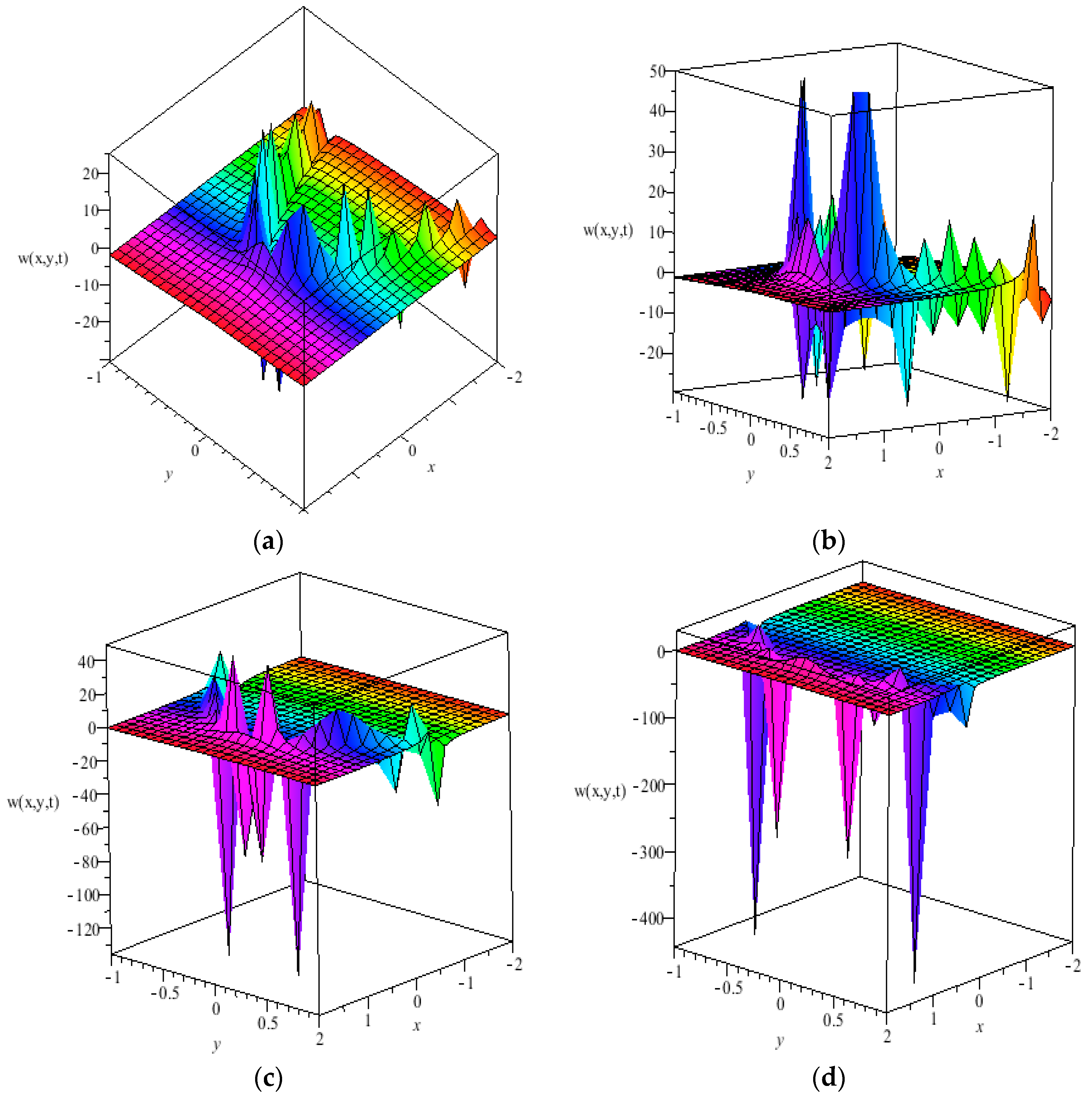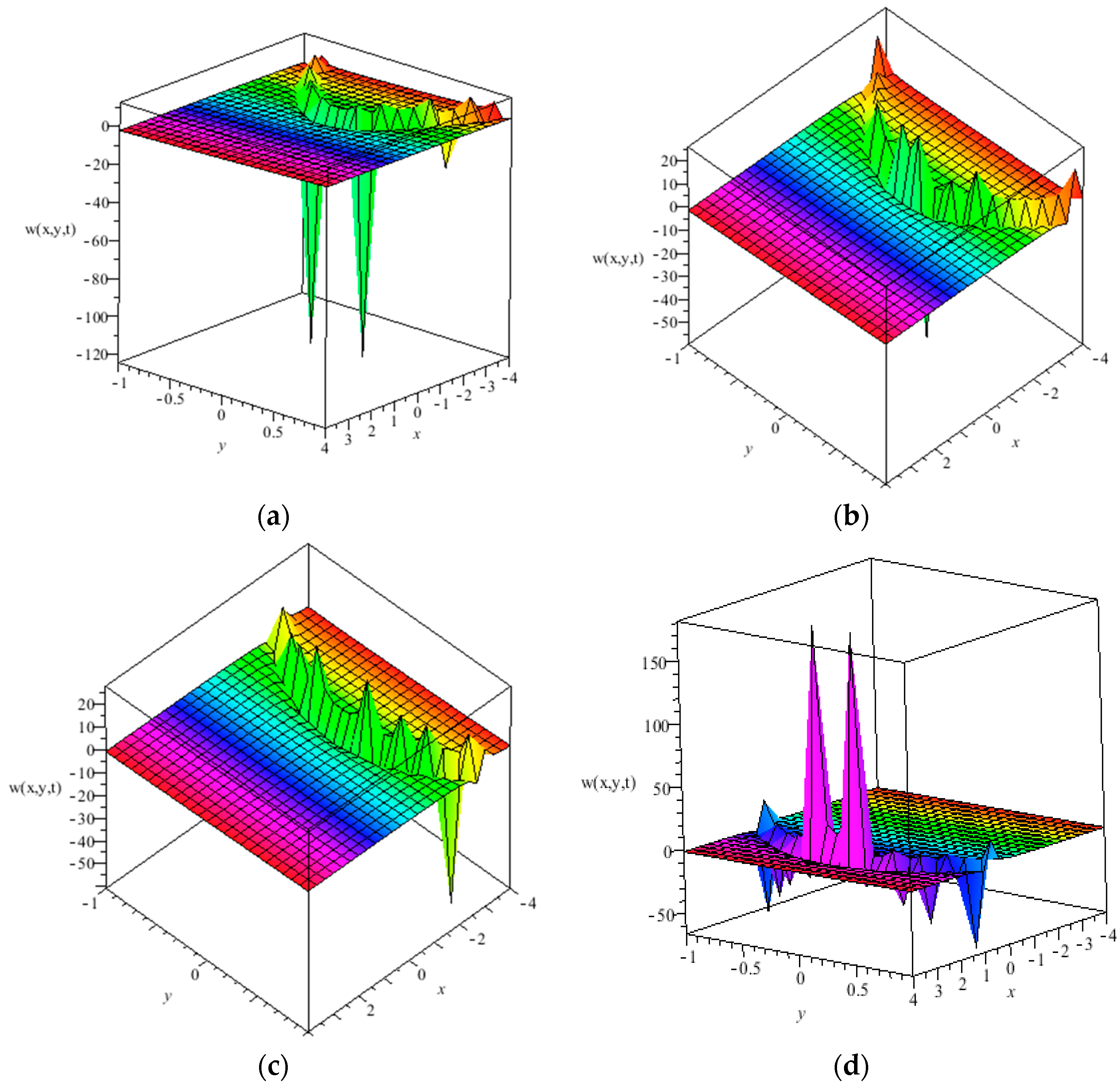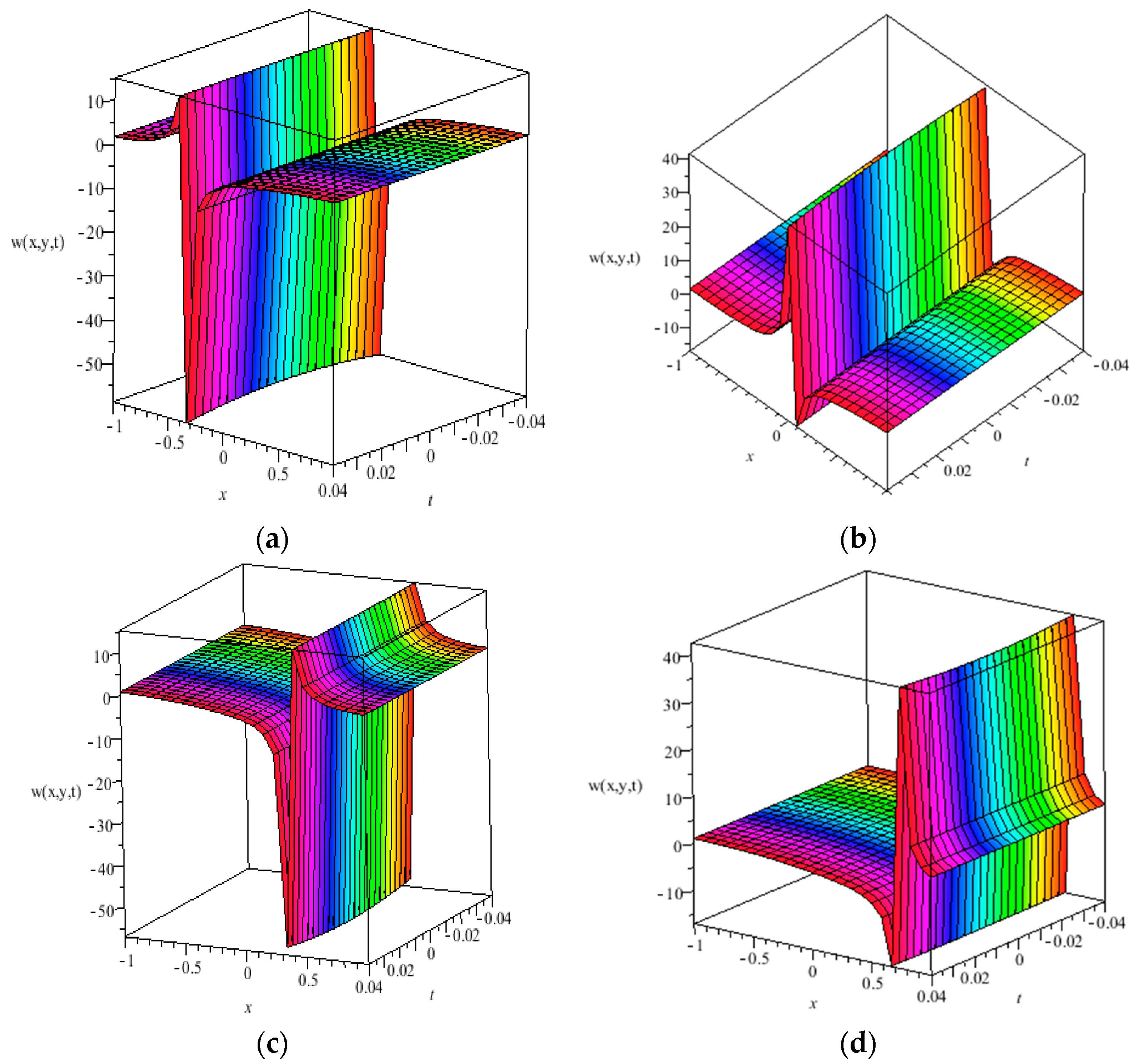Explicit Solutions for the (2 + 1)-Dimensional Jaulent–Miodek Equation Using the Integrating Factors Method in an Unbounded Domain
Abstract
:1. Introduction
- The JM partial differential equation variables (x, y, t) are reduced to a PDE in two variables (r, s) whose Lie symmetries are evaluated.
- These symmetries are used for a further reduction of independent variables from (r, s) to one variable ().
- The resulting ODE non-solvable equations, through their corresponding Integrating Factors are reduced to new solvable ones.
2. Mathematical Model
3. Reduction of the Independent Variables in Jaulent–Miodek Equation (2)
3.1. Reduction of the JM Partial Differential, Equation (2), Using
3.1.1. Integrating Factor Technique to Obtain an Explicit Solution
Reductions of Equation (8)
Reductions of Equation (8)
3.2. Similarity Reduction of Equation (2)
3.2.1. Reduction of Equation (22)
Integrating Factor Technique to Obtain Explicit Solutions
4. Analysis of Results
5. Conclusions
- For vector X8 we replaced two successive Lie reduction processes used in [16] with a unique integrating process that led to new solutions.
- For vectors X2 + X5, we solved ODEs with no quadrature and obtained a new solution (Equation (29)) using an integrating factor, different from the solutions in [16] that resulted from a two consecutive Lie reductions.
- Thus, we can say that the advantages of using integrating factors are as follows:
- New and different solutions are obtained if we use a Lie symmetry reduction from A to z.
- The reduction stages are reduced via Lie symmetry reduction.
- In practice, the integrating factor method perhaps obtains the solution more easily than does the Lie reduction.
- The problems of the Lie symmetry reduction method (back substitution problems) are thus overcome.
Author Contributions
Conflicts of Interest
References
- Bruzon, M.S.; Clarkson, P.A.; Gandarias, M.L.; Medina, E. The symmetry reductions of a turbulence model. J. Phys. A Math. Gen. 2001, 34, 3751–3760. [Google Scholar] [CrossRef]
- Xiao, H.; Young, Y.L.; Prevost, J.H. Parametric study of breaking solitary wave induced liquefaction of coastal sandy slopes. Ocean Eng. 2010, 37, 1546–1553. [Google Scholar] [CrossRef]
- Sarkar, S.; Basu, U.; De, S. (Eds.) Applied Mathematics; Springer: Kolkata, India, 2014. [Google Scholar]
- Biazar, J.; Eslami, M. A reliable algorithm for solving nonlinear Jaulent–Miodek equation. J. King Saud Univ. Sci. 2011, 23, 133–137. [Google Scholar] [CrossRef]
- Sadat, R.; Halim, A.A. New Soliton Solutions for the Kadomtsev-Petviashvili equation Using Darboux Transformation. Int. J. Mod. Math. Sci. 2017, 15, 112–122. [Google Scholar]
- El-Sayed, T.A.; El-Mongy, H.H. Application of variational iteration method to free vibration analysis of a tapered beam mounted on two-degree of freedom subsystems. Appl. Math. Model. 2018, in press. [Google Scholar] [CrossRef]
- Cariello, F.; Tabor, M. Painleve expansions for non integrable evolution equations. Phys. D 1989, 39, 77–94. [Google Scholar] [CrossRef]
- Wang, M.; Zhou, Y.; Li, Z. Applications of a homogenous balance method to exact solutions of nonlinear equation in mathematical physics. Phys. Lett. A 1996, 216, 67–75. [Google Scholar] [CrossRef]
- Fu, Z.T.; Liu, S.K.; Liu, S.D.; Zhao, Q. New Jacobi elliptic function expansion and new periodic solutions of nonlinear wave equations. Phys. Lett. A 2001, 290, 72–76. [Google Scholar] [CrossRef]
- Ma, W.-X.; Huang, T.; Zhang, Y. A multiple exp-function method for nonlinear differential equations and its application. Phys. Scr. 2010, 82, 065003. [Google Scholar] [CrossRef]
- He, J.-H.; Wu, X.-H. Exp-Function Method for Non-linear Wave Equations. Chaos Solitons Fractals 2006, 30, 700–708. [Google Scholar] [CrossRef]
- He, J.; Zhang, L. Generalized solitary solution and compacton-like solution of the Jaulent–Miodek equations using the Exp-function method. Phys. Lett. A 2008, 372, 1044–1047. [Google Scholar] [CrossRef]
- Sahoo, S.; Ray, S. New solitary wave solutions of time-fractional coupled Jaulent–Miodek equation by using two reliable methods. Nonlinear Dyn. 2016, 85, 1167–1176. [Google Scholar] [CrossRef]
- Wazwaz, A.-M. Multiple kink solutions and multiple singular kink solutions for (2 + 1)-dimensional nonlinear models generated by the Jaulent–Miodek hierarchy. Phys. Lett. A 2009, 373, 1844–1846. [Google Scholar] [CrossRef]
- Zhang, Y.; Liu, X.; Wang, G. Symmetry reductions and exact solutions of the (2 + 1)-dimensional Jaulent–Miodek equation. Appl. Math. Comput. 2012, 219, 911–916. [Google Scholar] [CrossRef]
- Rashed, A.S.; Kassem, M.M. Hidden symmetries and exact solutions of integro-differential Jaulent–Miodek evolution equation. Appl. Math. Comput. 2014, 247, 1141–1155. [Google Scholar] [CrossRef]



© 2018 by the authors. Licensee MDPI, Basel, Switzerland. This article is an open access article distributed under the terms and conditions of the Creative Commons Attribution (CC BY) license (http://creativecommons.org/licenses/by/4.0/).
Share and Cite
Sadat, R.; Kassem, M. Explicit Solutions for the (2 + 1)-Dimensional Jaulent–Miodek Equation Using the Integrating Factors Method in an Unbounded Domain. Math. Comput. Appl. 2018, 23, 15. https://doi.org/10.3390/mca23010015
Sadat R, Kassem M. Explicit Solutions for the (2 + 1)-Dimensional Jaulent–Miodek Equation Using the Integrating Factors Method in an Unbounded Domain. Mathematical and Computational Applications. 2018; 23(1):15. https://doi.org/10.3390/mca23010015
Chicago/Turabian StyleSadat, Rahma, and Magda Kassem. 2018. "Explicit Solutions for the (2 + 1)-Dimensional Jaulent–Miodek Equation Using the Integrating Factors Method in an Unbounded Domain" Mathematical and Computational Applications 23, no. 1: 15. https://doi.org/10.3390/mca23010015
APA StyleSadat, R., & Kassem, M. (2018). Explicit Solutions for the (2 + 1)-Dimensional Jaulent–Miodek Equation Using the Integrating Factors Method in an Unbounded Domain. Mathematical and Computational Applications, 23(1), 15. https://doi.org/10.3390/mca23010015




